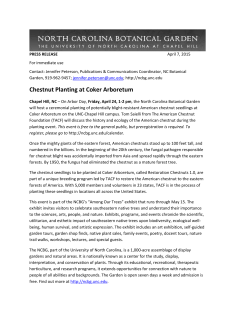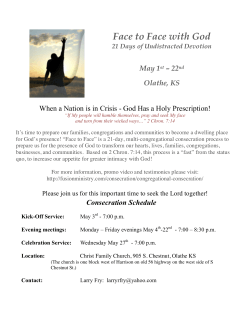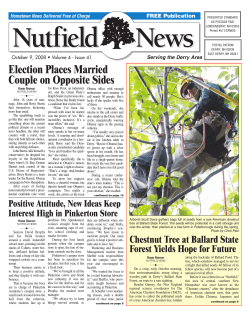
GE American Chestnut Fact Sheet - Global Justice Ecology Project
GENETICALLY ENGINEERED AMERICAN CHESTNUTS By Global Justice Ecology Project Background unstudied, but likely include damaging effects to other plants and animals, soils, water, and the foundational bacterial organisms that create a healthy ecosystem. When we are talking about trees like American chestnuts, however, that can live for up to 250 years and spread pollen and seeds across a wide range, these impacts are likely to be considerable and almost impossible to predict. W ild American chestnut trees (Castanea dentata) were a dominant part of the North American Eastern Woodlands. They ranged from Maine and Southern Ontario to Mississippi, and from the Atlantic coast to the Appalachian Mountains and the Ohio Valley. At one point it is estimated that the American chestnut represented 1 in every 4 trees in its range. This included 4 billion trees over 200 million acres. During the early 1900’s a pathogenic fungus known as Chestnut Blight (Cryphonectria parasitica) was brought into New York City from Asia and began decimating the chestnut population. The Chestnut Blight is thought to have been introduced by the importation of the Japanese chestnut (Castanea crenata), which was a popular imported ornamental tree at the turn of that century. Wheat Gene Mutations Original American chestnut range/USGS unrelated species in a way that would never occur in nature. These new organisms are designed to benefit the needs of industry. They have unknown and unknowable risks to nature. One of the principle GE chestnut strains being developed has been engineered with DNA from wheat. This engineering process damages the chestnut genome and leads to numerous mutations. This means that the engineered tree will likely have unanticipated and unpredictable consequences when released into a forest ecosystem. As we’ve seen time and again with GMO crops, these unanticipated consequences can be very damaging to biodiversity and wildlife, and humans. SUNY/ESF has announced that they want to introduce GE chestnuts into the wild so that they can “pollinate” (contaminate) as many existing wild American chestnuts as possible with their engineered genes. This is both Now corporations have partnered dangerous and potentially with the American Chestnut Industry/Academic destructive to the ecosystems Foundation and the State University they claim to protect. The long Propaganda of New York at Syracuse, College range impacts of the irreversible of Environmental Science and The SUNY/ESF strategy to promite contamination of a native Forestry (SUNY/ESF) to develop GE chestnuts for environmental ecosystem with genetically genetically engineered (GE) blight engineered trees are virtually resistant American chestnut trees. They plan to release these GE trees Global Justice Ecology Project in wild forests under the false claim that this will help save and restore 266 Elmwood Avenue, Suite 307 native forests. Buffalo, NY 14222 716.931.5833 Why GE Chestnuts are bad Genetic engineering is not the same as traditional cross breeding. GE creates new organisms by crossing one species with a completely globaljusticeecology.org email: info@globaljusticeecology.org conservation is widely viewed as part of an industry sponsored strategy to build political momentum for the approval of other GE forest trees. This strategy is based on profit and not on ecology or environment. Industry propaganda also promotes GE trees as a solution to climate change. Part of this strategy involves engineering trees such as eucalyptus, poplar, and pines for bioenergy production. The expansion of plantations of GE trees for bioenergy will lead to the destruction of wild forests and other wild areas, create more chemical contamination, monopolize more water, and displace people. At particular risk around the globe are Indigenous peoples and forest dependent communities without clear land title. Additionally, The carbon released in the production and burning of bioenergy as well as the destruction of forests for GE tree plantations will worsen, not mitigate, climate change. Multinational timber companies like MeadWestvaco, International Paper and Suzano want to create genetically engineered trees for a range of profit-based purposes including faster growing industrial tree plantations. These GE tree schemes are focused on expanding the profits of biotechnology, pulp and paper, biofuel, lumber, and energy industries. Part of the scheme involves strategies to evolve forestry/ ecosystem practices and regulations into agricultural contexts. It is unfortunate but hardly unprecedented that a state funded college would accept money from industry at the expense of the environment, society, and wider economic benefit. and bad for the wild American chestnut tree. GE chestnuts and all GE trees are false solutions to climate change. The move toward GE trees will destroy forests and expand unsustainable land use. It will increase chemical contamination, worsen climate change, devastate biodiversity, and turn forest dependent communities into refugees, or worse. • Visit our website, nogetrees.org and our GE American chestnut resource section listed there to learn more about the social and ecological dangers of GE trees and our efforts to combat them in the US and globally. • Join the movement in New York against the introduction of GE American chestnuts and help us to reach others in your network by sharing this factsheet and our online materials in your networks. • Sign up for our GE American chestnut mailing list (bit.ly/ AmChestnut-listserv) so that we can keep you updated and informed about our activities. We want to engage you in action strategies to fight against those that are causing harm to our life-supporting ecosystems. • Contact GJEP by calling (716) 931-5833 or emailing us at info@globaljusticeecology.org Precautionary Principle The Precautionary Principle advises society to be cautious about a technology or practice where there is scientific uncertainty, ignorance, gaps in knowledge, or the likelihood of outcomes we have not predicted or intend. This Principle is codified in the Rio Declaration on the Environment (Principle 15). Because there is no way to adequately assess the risks of GE American chestnuts, they must be banned from environmental release. Let Nature Work The American chestnut still exists throughout the forests of the Eastern US. Many of the trees that were killed off by the blight re-sprouted from the stumps. Many of these have survived to the point where they are producing chestnuts that are being harvested by people and feeding wildlife. There is also active work being undertaken to identify and breed naturally resistant wild American chestnuts, to bring back real resistant wild American chestnuts—not engineered facsimiles. What you can do Timothy Van Vliet 2004 GE American chestnut trees are bad for the environment, bad for forest ecosystems, Here’s what you can do to help:
© Copyright 2025










